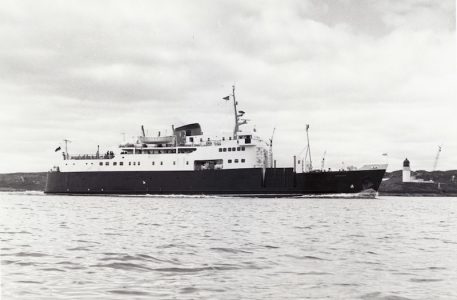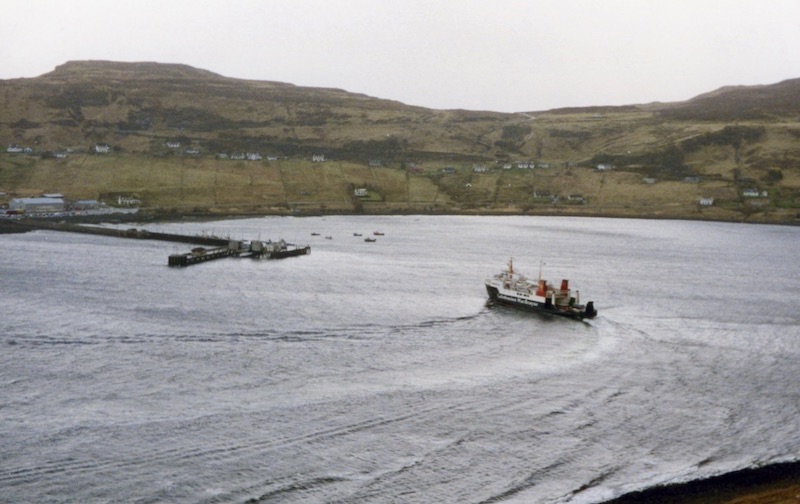
Suilven at Stornoway: the 1978 Report argued that more passenger capacity was needed on the service to Ullapool. Does that sound familiar? Copyright CRSC Tom Duthie Collection
Following Transport Scotland’s recent decision to commission a consultants’ report into the future of Hebridean ferry services, Colin Tucker uncovers a similar consultants’ report from 40 years ago that also tried to crystal-gaze the future. Just how useful was it?
In November 1978, beneath the headline ‘Possible changes in island ferry terminals’, the Stornoway Gazette published details of a ‘lengthy and detailed’ Report exploring options for changing and improving ferry services to the Outer Hebrides.
Commissioned by Caledonian MacBrayne, the Report was written by ‘two prominent lecturers at Glasgow University’, J.G.L. Adams and J.D. McCallum, although no details of the subjects in which they were specialists were given. Coming 14 years after Hebridean car ferry services were first established, the Report suggested existing ferry routes were not set as tablets in stone, and that CalMac was continually examining ways to improve its services, by cutting route length, reducing journey times and upgrading ferries.

A replacement for the side-loading Hebrides was considered crucial. She is pictured passing Arnish Lighthouse, on one of her rare visits to Stornoway. Copyright CRSC John Murdo Macmillan Collection
The Report was of considerable interest to islanders, always aware of the importance of ‘their’ ferries, but few of its recommendations were implemented — and those few came into being more because of the general drift of policy rather than for any particular insights provided by Adams and McCallum. More than anything else the Report seems to have been a basis for discussion, as if CalMac needed an independent voice to analyse its services and float possible ideas ‘outside the box’.
The stated aim was ‘to improve knowledge and understanding of the factors influencing the requirements to be met, to assess the effectiveness of present operations relative to these requirements and to evaluate alternative strategies for the future.’ Before readers could react to this wordiness, CalMac’s Managing Director John Whittle pre-empted adverse reaction in the islands by saying the company had no plans to axe the Skye-Harris-Uist service — the main focus of the Report — and was in fact ‘very anxious’ to keep it going.
While the Report found that Stornoway was the more convenient port for 88 per cent of the people of Lewis and Harris, it said the main route to Lewis was via Harris, and the removal of the Skye-Harris link ‘would create much bitterness and local distress.’
On the surface, these two findings appear to contradict each other — maybe because the Report came out strongly in favour of short sea crossings, and was published amid fears in Lewis and northern Harris that the link to the mainland via Skye might in the long run be developed at the expense of Stornoway-Ullapool.

The Report said a case could be made for focusing all Uist traffic on a single port, citing a preference for Loch Carnan — seen here with the tank landing craft Audemar
With respect to the Uists and Benbecula, the Report suggested that, while two ports (presumably the existing ones of Lochmaddy and Lochboisdale) were more convenient for residents, there was a case to be made for focusing on a single port, sited in the middle of the island chain — for example at Loch Carnan. This was, in fact, the favoured long-term option, provided a suitable service could be provided to Barra.
With regard to the local economy, the Report stated that the existing ferry system (supplemented by charters) could cope with livestock traffic, although the withdrawal in 1976 of MacBrayne’s cargo boat Loch Carron had increased the price of hay. While fishing was important in communities such as Scalpay and Eriskay, it was unlikely to create much demand for ferry space.
On the other hand, it suggested that oil-related traffic was the ‘greatest unknown’ of future traffic, and that CalMac should ‘cultivate close contacts’ with Western Isles Council (now Comhairle nan Eilean Siar) and the Ministry of Defence to obtain advance warning of possible capacity problems. The last-mentioned point was in response to complaints about Army pre-emption of space on Iona and Hebrides, but the report found these to be exaggerated. The withdrawal of Loch Carron was not considered to have been a significant factor in the growth of ferry traffic.
With regard to tourism the Report was ahead of its time in suggesting that the concentration of tourism on the Uig-Tarbert service posed problems for CalMac. ‘The basic problem,’ it said, ‘[is] that over half the annual total of cars and of passengers has to be carried in a twelve week period in the summer’ — a problem that continues to this day on most Hebridean routes.
It stated that in terms of vehicle capacity Suilven was adequate at all times, but did not have ‘sufficient passenger capacity even at present levels of use’, and ‘consideration should be given to the possibility of providing additional passenger space.’ Regarding the 1964 Hebrides, it found that the situation was reversed. ‘There is no spare vehicle capacity between Uig and Tarbert, and traffic is probably being lost’, while ‘the passenger accommodation is ample, comfortable and well liked.’
The Report made a number of recommendations. The navigational feasibility of a regular vehicle ferry between Barra and South Uist should be investigated (but there was no suggestion of a Sound of Harris ferry). A craft shop should be operated on an experimental basis on board Hebrides. Signs and announcements should be in Gaelic as well as English. The service between Barra and the mainland should be improved. ‘Various complaints about services should be investigated and action taken where necessary’ — a recommendation so vague as to be totally unnecessary.
It said Dunvegan ‘would be a superior port to Uig’ but recommended that a study of alternatives be made before ‘Uig pier is replaced’, the cost of which would be nearly as much as a new pier elsewhere.
A replacement for Hebrides was considered crucial. The new vessel should have greater capacity and be able to take vehicles which were ‘forced’ to use the Stornoway route because of Hebrides’ limited ramp size and weight restrictions. The Uig triangle should be upgraded to ro/ro standard, though this was not considered necessary if the new vessel was capable of taking large, fully-laden lorries.
Almost 40 years on it is worth considering how much of the Report was acted on. No changes have been made to the routes to Lewis and Harris, while Lochmaddy and Lochboisdale remain as termini for the Uists and Benbecula — although, as a result of local campaigning rather than any report, Lochboisdale now has a link with Mallaig, redolent of the old Outer Isles mail service. Oil- and defence-related traffic today is negligible while, as the Report forecast, it is tourism which is now the mainstay of revenue, and still with a very short season.

It was not until 1985 that Hebrides, pictured arriving at Lochmaddy, was replaced by Hebridean Isles. Copyright CRSC Archive Collection
The ships have changed. Suilven, a victim of her own success on the Stornoway run, was superseded in 1995 by the larger Isle of Lewis, which has since been succeeded by Loch Seaforth.
On the Uig triangle, it took another seven years after the Report before the hoist-loading Hebrides was replaced by a new ro/ro ferry, Hebridean Isles. The comment about accommodation on the 1964 Hebrides, with regard to both vehicles and passengers, similarly applies to the present ship of that name: it may be that her replacement, currently under construction at Port Glasgow, will attract even more tourist traffic on the Uig triangle, creating yet more problems. The Skye terminal remains Uig. Long before the report, Dunvegan was considered as an alternative, but given the improvements on the road to Uig, it is unlikely such a change will ever come about.
Similarly, it seems unlikely that the mainland terminal for the Stornoway service will ever be moved from Ullapool (such as to a point nearer the mouth of Loch Broom). Of the other recommendations, three are now in place. A ferry links Barra and Eriskay, and there is a daily service from Barra to the mainland. It is good to see signs and announcements in both English and Gaelic, though there is no evidence to suggest these or any other changes came into being as a result of the Report’s findings. We have yet to see a craft shop on any CalMac ferry.
The Report tried to offer strategic thinking on routes that were still in a developmental phase, but it had no executive teeth and shied away from radical proposals, such as deep-water terminals to replace the confined harbours at Lochboisdale and Tarbert.
Like many other consultants’ reports, it was overloaded with generalised postulations and equivocations, mixing informed guesswork with statements of the obvious. In the light of the intervening 40 years, the 1978 Report can be seen a quirky footnote in the ongoing development of services to the Hebrides.

The withdrawal of the MacBrayne cargo boats in the early-to-mid 1970s was not considered to have been a significant factor in the growth of ferry traffic. The last to go was Loch Carron, seen at Lochboisdale in 1973. Copyright CRSC Archive Collection

John Whittle, CalMac’s first Managing Director (in light-coloured suit), was at the height of his influence when the Report was commissioned in 1978

Hebridean Isles’ drive-through facilities caused a revolution on the Uig triangle service. Copyright CRSC Archive Collection
Also by Colin Tucker:
Lochs and Lochs, or ‘sailing in home waters’
Crossing the Minch — Variations on a Theme
Colin Tucker’s widely admired book Steamers to Stornoway is available in the CRSC Shop.
Catch up with all CRSC’s posts at News & Reports












